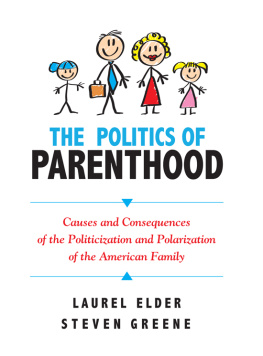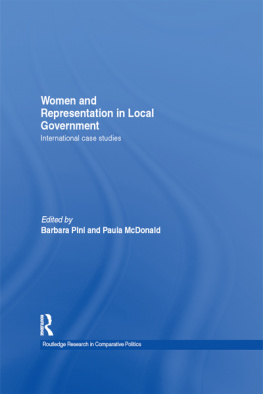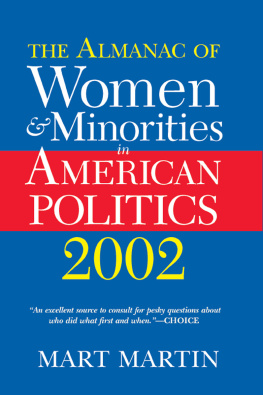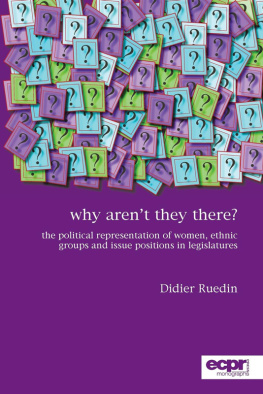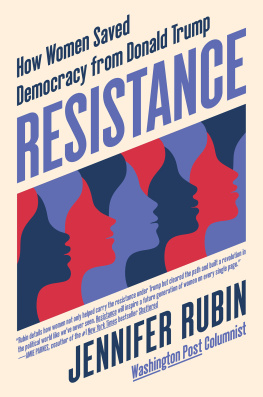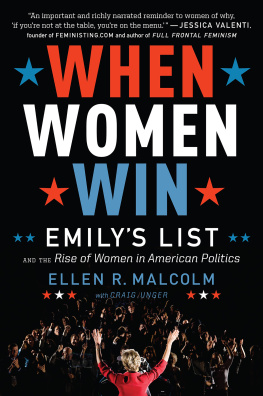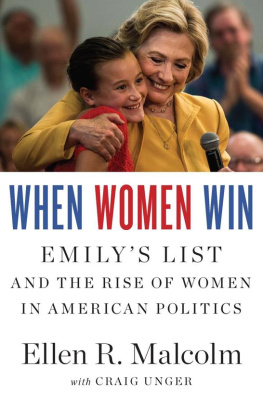Contents
Guide
Pagebreaks of the print version
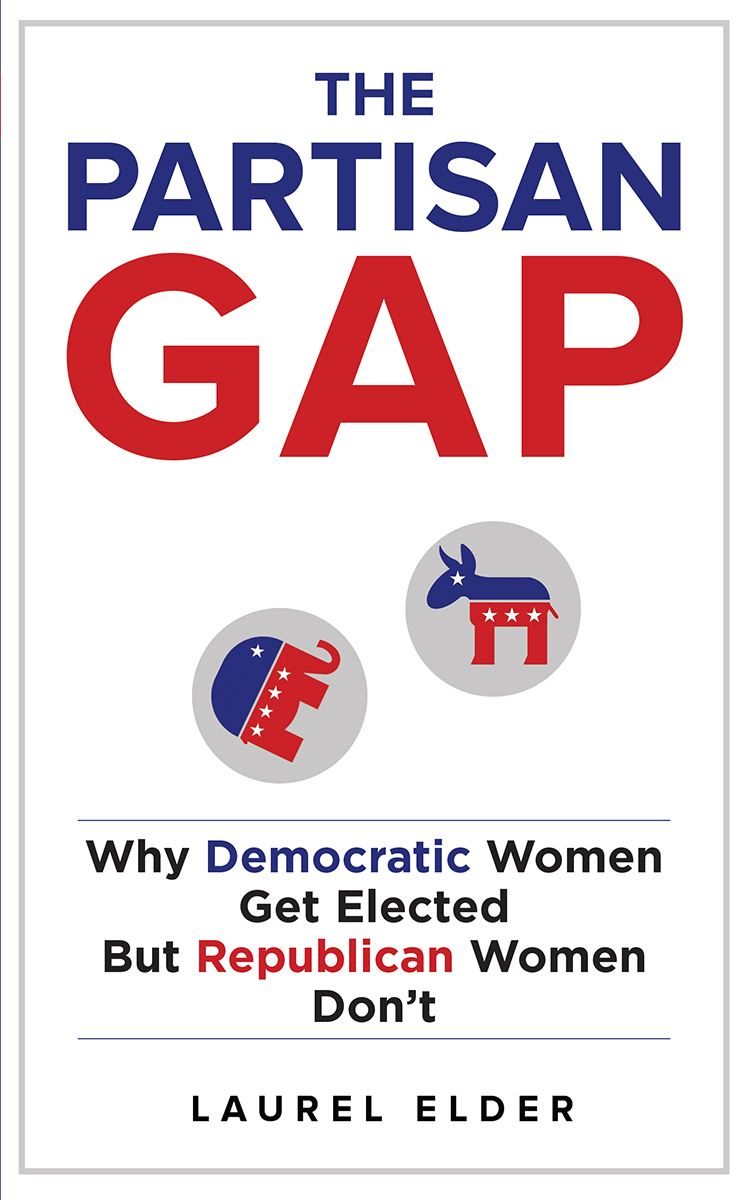
THE PARTISAN GAP
The Partisan Gap
Why Democratic Women Get Elected But Republican Women Dont
Laurel Elder

NEW YORK UNIVERSITY PRESS
New York
NEW YORK UNIVERSITY PRESS
New York
www.nyupress.org
2021 by New York University
All rights reserved
References to Internet websites (URLs) were accurate at the time of writing. Neither the author nor New York University Press is responsible for URLs that may have expired or changed since the manuscript was prepared.
Library of Congress Cataloging-in-Publication Data
Names: Elder, Laurel, author.
Title: The partisan gap : why Democratic women get elected but Republican women dont / Laurel Elder.
Other titles: Why Democratic women get elected but Republican women do not
Description: New York : NEW YORK UNIVERSITY PRESS, [2021] | Includes bibliographical references and index.
Identifiers: LCCN 2020048480 | ISBN 9781479804818 (Hardback : acid-free paper) | ISBN 9781479804825 (Paperback : acid-free paper) | ISBN 9781479804849 (eBook) | ISBN 9781479804870 (eBook Other)
Subjects: LCSH: Political partiesUnited StatesPlatforms. | Democratic Party (U.S.)History. | LiberalismUnited StatesHistory. | Republican Party (U.S. : 1854)History. | ConservatismUnited StatesHistory. | Political cultureUnited StatesHistory. | LegislatorsRecruitingUnited States. | MinoritiesPolitical activityUnited StatesHistory. | WomenPolitical activityUnited StatesHistory. | Women legislatorsUnited StatesHistory. | Women political candidatesUnited States.
Classification: LCC JK2255 .E66 2021b | DDC 324.273dc23
LC record available at https://lccn.loc.gov/2020048480
New York University Press books are printed on acid-free paper, and their binding materials are chosen for strength and durability. We strive to use environmentally responsible suppliers and materials to the greatest extent possible in publishing our books.
Manufactured in the United States of America
10 9 8 7 6 5 4 3 2 1
Also available as an ebook
CONTENTS
PREFACE
The analyses for this book were completed in summer 2020, as anticipation was building for the 2020 elections. While no woman ran as either partys presidential nominee, Kamala Harris was elected in November 2020 as the first woman vice president of the United States. The 2020 elections also saw a record number of women run and win legislative office, shattering the records set in 2018.
Yet, the story of womens representation in elective office is a tale of two parties. For the past several decades, Democratic women have made steady, impressive gains in state legislatures and Congress, and they are on a clear path toward equal representation among their partys elected officials. Progress for Republican women, however, has stalled and in many cases reversed, leaving the Republican party-in-government more male-dominated today than three decades ago. As a result of these contrasting partisan dynamics, as of 2020, there are five times as many Democratic women in Congress as Republican women.
This book argues that the causes of the dramatic partisan gap among women in elective office are not short-term or idiosyncratic but grounded in structural forces that have reshaped the American party system over the last half century. The racial, ideological, and regional realignments of the Democratic and Republican partiestransformations that have received widespread discussion in scholarly literature as well as the popular presshave also had a tremendous impact on womens representation, which has received far less attention. These structural changes to the American political landscape have resulted in favorable opportunities for the advancement of a diverse group of Democratic women and a more challenging and unwelcoming environment for Republican women office seekers.
The argument advanced in this book suggests that the gains made by women in elective office in future election cycles will primarily be driven by Democratic women and will result in the continuation of the already dramatic partisan gap among women in state legislatures and Congress. The partisan gap among women officials is driven by the broad structural forces shaping contemporary American politics. As a result, the strikingly different levels of representation of Republican and Democratic women in elective office is unlikely to meaningfully abate until there is a new party realignment that reshapes the party coalitions and electoral environment in the United States.
Introduction
The Partisan Dynamics of Womens Representation
There are many compelling reasons to be concerned about womens underrepresentation in elective political office. Women compose slightly more than 50 percent of the population in the United States but remain dramatically underrepresented in all types of elective political office, from state legislatures, to Congress, to governorships. The United States has yet to elect a woman as president. Many believe American democracy would be healthier and stronger if its elected officials were a more accurate reflection of the public.
Having women descriptively represented in political office allows women and girls to see people like themselves in positions of power and lends legitimacy to the political system.
For those who value womens representation and believe that our democracy would be stronger if women were represented proportionally, the past several decades have been frustrating. Womens representation in political office has increased only at a very slow rate. In fact, in some years, the number of women in the US House of Representatives and in state legislatures actually went down, challenging the assumption that progress toward equal representation by gender might be slow but would inevitably happen.
The 2018 elections marked a departure from this glacial progress as women smashed existing records for political office holding. The 116th Congress (20192021) has within it a record-breaking 26 women in the Senate and 101 women in the House of Representatives.
Behind the good news about womens increased representation in elected office is another story, one about the political parties and the different experiences women are having within them as office seekers and members of the party-in-government. While womens representation in elective office is at an all-time high, the size of the partisan gap between the representation of Democratic women and Republican women is also record-breaking. Today, an overwhelming majority of women in elective office are Democrats, while Republicans form a small and, in many cases, shrinking portion of women in elective office.
An overwhelming 83 percent of the women in the 116th Congress are Democrats, while just 17 percent are Republicans. Put another way, there are more than four times as many Democratic women in Congress than Republican women. A large partisan gap also characterizes womens representation in state legislatures. Democratic women compose 68 percent of women state legislators, while Republican women form less than one-third. While women in society overall are somewhat more likely to affiliate as Democrats than Republicans, the partisan gap among women elected officials far exceeds the partisan gap among women in the electorate. The magnitude of the partisan gap among women in Congress and state legislatures is all the more dramatic considering it is a relatively new feature of American politics. Until the 1990s, women in elected office were equally likely to be Republicans and Democrats.


